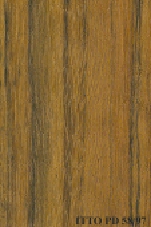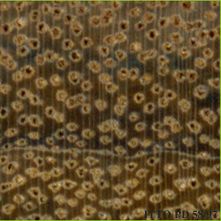
OVENGKOL (Guibourtia ehie)
Trade Name
Ovengkol
Scientific Name
Guibourtia ehie J.Leon.
Family
LEGUMINOSAE
Common Names
Amazakoué (Côte d`Ivoire); Mozambique (United States of America); Amazoue (Côte d`Ivoire); Ehie (Ghana); Mozambque (United States of America); Palissandro (Equatorial Guinea); Ovengkol (Gabon); Anokye (Ghana); Hyeduanini (Ghana); Ovangkol
Scientific Name Synonyms
Copaifera ehie A. Chev.
Description Of The Tree
Botanical Description
The tree reaches a height of 40 m. The bole is occasionally fluted. The trunk diameter attains 120 cm.
Natural Habitat
Guibourtia ehie occurs in moderate densities in different forest types, from closed rain forest to drier semi-deciduous forest. It prefers swampy and periodically inundated forests. It is known or inferred that the harvesting of specimens from the wild fo
Wood Identification
Anatomic Description Of Wood
Wood diffuse porous. Occasionally vessels exclusively solitary (over 90%). Tangential diameter of vessel lumina 100 to 150 micras (small). Vestured pits. Vessels per mm2 6 to 10 (medium). Simple perforation plates. Vessel-ray pits similar to intervessel pits in Axial parenchyma in marginal or in seemingly marginal bands. Paratracheal axial parenchyma scanty and/or vasicentric. Axial parenchyma lozenge-aliform. Axial parenchyma aliform. Prismatic crystals in chambered axial parenchyma cells and/or in fibers. 5 to 8 ce 4 to 10 rays per mm (medium). Rays non-storied. Larger rays more than 4 seriate. Homogeneous rays and/or sub-homogeneous rays (all ray cells procumbent). Non-septate fibers. Fibers with simple to minutely bordered pits.
-
 Wood Macro Photo Tangential Plane
Wood Macro Photo Tangential Plane
-
 Wood Micro Photo Of Transversal Section
Wood Micro Photo Of Transversal Section
Availability
Cites Status
Unrestricted
General Wood Description
Color
The sapwood is greyish white, it has a thickness of 4 to 7 cm. The heartwood is yellow brown to dark brown, it is clearly demarcated. The silver figure is slightly lustrous.
COLOR INDEX (1=Black, 7=Light yellow,white)
4
Grain
It has highly interlocked grain.
Texture
The texture is typically fine to medium.
Luster
This species is moderate in luster.
Natural Durability
Durable to decay; this species can be utilized without preservative treatment for exterior joinery or similar uses. Resistant to termites attack. Heartwood is resistant to Lyctus attacks.
Natural durability index (1= Very high durability, 7=Vey low durability)
1
Internal Growth Stresses
Residual growth stresses are absent.
Silica Content
Silica Content: Negligible content of silica is reported. Amounts over 0.05% may affect wood processing. Silica Value: 0
Resistance To Impregnation
Difficult to treat with only a low penetration of the preservative products.
Wood Physical Properties
Basic Density or Specific Gravity (O.D. weight/vol. green) (g/cm³)
0.73
Air-dry Density (Weight and volume at 12%MC) (g/cm³)
0.82
Total shrinkage Tangential (Saturated to 0%MC) (%)
8.0
Total shrinkage Radial (Saturated to 0%MC) (%)
3.9
Recommended Dry Kiln Schedule
FR-9
Dimensional stability ratio (Total Tangential Shrinkage %/Total Radial Shrinkage %)
2.0
Wood Chemical Properties
Wood Mechanical Properties
Bending Strength (MOR),12%MC (kgf/cm²)
1296
Stiffness (MOE) 12%MC (kgf/cm²)
218862
Compression parallel to fiber 12%MC (kgf/cm²)
705
Compression perpendicular to fiber 12%MC (kgf/cm²)
98
Shear strength radial 12%MC (kgf/cm²)
115
Janka hardness (side) 12%MC (kgf)
845
Janka hardness (end grain) 12%MC (kgf)
914
Workability
Sawing
Sawing of this species requires powerful equipment.
Rotary Veneer Cutting
Suitable for slicing.
Sliced Veneer
Suitable for slicing.
Blunting Effect
Moderate blunting effect; stellited blades for sawing and carbide tools for machining are advised.
Machining
It needs powerful tools for processing. Possible difficulties caused by interlocked grain are reported.
Planing
Moderately easy; tools must be cautiously sharpened.
Moulding
Rather difficult; special tools are needed.
Turning
30
Boring
Rather difficult; special tools are needed.
Mortising
Rather difficult; special tools are needed.
Nailing
Pre-boring is necessary.
Gluing
Difficult to glue because of high density.
Sanding
Easy to perform; it gives good results.
Polishing
Can be polished without surface preparation.
Response To Hand Tools
Working with hand tools is difficult.
REFERENCED USES
End Uses Summary
HOUSING GENERAL, boards, flooring, parquet, frames, steps, panelling, fittings, FURNITURE AND CABINETS, luxury furniture, cabinets, PLYWOOD AND VENEER, Decorative veneer, TURNING, ornaments, turned furniture, cutlery, lasts, OTHER AND MUSICAL INSTRUMENTS, handicrafts
General Housing
- 10 - Silica in Timbers
Boards
- 13 - Dry kiln schedules for commercial woods. Temperate and tropical. Section III. Latin American (Mexico, Central, and South America) Woods–Conventional Temperatures
Flooring
- 14 - Handbook of Hardwoods
Parquet
- 15 - Empire Timbers
Frames
- 16 - Woods of the World
Steps
- 17 - Tree Conservation Database
Paneling
- 18 - W3TROPICOS Missouri Botanical Garden
Fittings
- 19 - Silica in Timbers
Furniture Cabinets
- 21 - Tropical timbers of the world. Part III-Southeast Asian and Oceanian Species.
Furniture, Luxury
- 22 - Dry kiln schedules for commercial woods. Temperate and tropical. Section IV-Asian and Oceanian Woods
Cabinet
- 24 - Empire Timbers
Panels, Veneers
- 25 - Directory of Timber Trade Malaysia
Decorative veneer
- 28 - Ministry of Agriculture, Fisheries & Forest of Fiji
Turning
- 30 - Embassy of Honduras in Japan
Ornaments
- 31 - Embassy of Colombia in Japan
Turned Articles
- 32 - Embassy of Cote d`Ivoire in Japan
Knife Handles
- 33 - Embassy of Gabon in Japan
Lasts
- 34 - Embassy of Indonesia in Japan
Other & Musical Instruments
- 63 - Madeiras do Brazil II
Handcraft
- 66 - Maderas latinoamericanas. VII. Caracteristicas anatomicas. propiedades fisicomecanicas, de secado, y tratabilidad de la madera juvenil de Cordia alliodora (Ruiz & Pav. Oken.)
Please Provide Information To View Producer Information